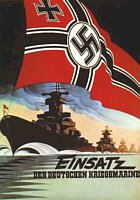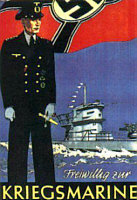The Kriegsmarine
Versailles and the German Navy
The imposition of the terms of the Treaty of Versailles following the end of the First World War was to affect all of Germany's armed forces; of these, it was the Imperial Navy that had found itself the most badly affected. Due to ongoing British fears of the German threat to its long-held supremacy on the high seas, the Imperial German navy (or Reichsmarine, as it was to become known in 1921) was to say the least derisory, a once-grand force reduced to a flotilla of dredgers, tug-boats and old battleships that had seen better days.
Much of the blame inside Germany for Versailles had been placed on the Navy; the unrestricted U-boat campaign in particular was seen by many as one of the key factors behind the harsh restrictions that had been imposed on the Germany military in general. In addition to this, many had seen the scuttling of the High Seas Fleet as an expensive catastrophe. Some had even cast doubt on the need for a Navy, a view shared by one Adolf Hitler, who had lambasted the wartime conduct of the Imperial Navy in his book Mein Kampf.
Raeder takes command
At the beginning of October 1928 the development of the Reichsmarine as a potential fighting force was placed in the hands of one man - Erich Raeder, a career sailor and First World War veteran who was the master of his craft. An apolitical officer with a keen brain, Raeder got to grips with his task with gusto. Perhaps the hardest part of this task was to persuade the German leadership that the Navy was once more a viable option. Acquiring the support of the influential General Hindenburg in the German parliament, Raeder was finally able to secure the funding for the start of his rebuilding project. There had been some limited research and development going on in secret before the time of Raeder's appointment, but with the securing of the additional funds this went into overdrive.
The secret research activities were carried out under the aegis of foreign "projects", with many new tanks, aircraft and submarines being planned, designed and tested outside Germany. Much of this went on in countries as far-flung as Finland and Spain, while significant research was also carried out in collusion with the Soviet Union, the other international pariah at the time. The U-boat in particular had been one section of the post-war navy that had been completely outlawed by the terms of Versailles; nevertheless, research into the further development of these craft had been carried out under the umbrella of a Dutch firm, Ingenieurskantoor voor Scheepsbouw (IvS), a front for the powerful Krupp concern.
The Kriegsmarine rearms
The cloak-and-dagger approach went on for a number of years, finally coming to an end in March 1935, when Hitler formally abandoned Germany's adherence to the Versailles terms. The Reichsmarine was renamed the Kriegsmarine, or "Combat Navy", and production of new vessels began to take on a new edge. Hitler had long since abandoned his previous thoughts on the future of the Navy - now seeing it as essential to his vision of a new, more powerful Germany - and threw the weight of his support in Raeder's direction.


Two wartime Kriegsmarine posters. i. One of the most famous German posters of the war, the recruitment advertisement for the newly-formed Kriegsmarine. ii. Another recruitment poster, advertising the U-boat arm.
British attitudes towards German rearmament, while still far from one of acceptance, had softened somewhat - and despite strong words from some quarters a blind eye was turned towards Hitler's open breach of what was International Law. On 21 May 1935, the Reichsmarine was renamed the Kriegsmarine, with research and development cranked up to new levels. The British ambivalence towards German rearmament was confirmed not long afterwards when the Anglo-German Naval Agreement of 18 June 1935 was signed, with Britain "allowing" Germany to re-equip its Navy, albeit up to a strength thirty-five percent of that of the Royal Navy, at the time the most powerful seaborne force in the world. The calculations were made as follows:
- Battleships - 184,000 tons
- Heavy Cruisers - 51,000 tons
- Light Cruisers - 67,000 tons
- Aircraft Carriers - 47,000 tons
- Destroyers - 52,000 tons
- U-boats - 24,000 tons
In what appeared to be a significant turnaround from the terms of Versailles, submarines were given special attention, with it being stipulated that the German U-boat fleet would be capped at forty-five percent of the size of the Royal Navy's submarine arm. In fact, as shown by the figures above, this was not much of a concession, as the British themselves had a fairly small submarine force due to the strategy of Royal Navy being essentially a defensive rather than an offensive one. On 29 June 1935, less than a fortnight after the new agreement had being signed, the U-1 - the first of what was to be a long line of new, more advanced U-boats - was rolled out of the factory at Kiel. The first U-boat flotilla, "Weddingen", was to be commanded by a veteran of the First World War U-boat fleet, Fregattenkapitän Karl Dönitz, a talented, ambitious officer who was soon to become the head of the U-boat arm.
next »